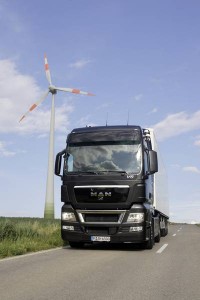sarath kumar.s.nair
HISTORY
The Belarusian-German Joint-Stock Company "MAZ-MAN» was created to produce modern heavy trucks of European class for regional and international transportations.
An agreement on a joint venture between its founders was signed on 10December 1997. 5 March 1998 Belarusian-German Closed Joint Stock Company "MAZ-MAN» was registered. Already at the end of April 1998 the first vehicle was assembled, and in October of the same year started upthe vehicle production.
Founders of the company were the German automobile concern «MAN Nutzfahrzeuge AG» (Munich), RUE "Minsk Automobile Plant (Minsk), Bank «Infobank» (Minsk) and others.
«MAZ-MAN» became the first automobile manufacturers in Belarus, whoconform the requirements of European regulations and directives, including rules of the UN / ECE standards regulating the level of exhaust and noise.
Since 2005, in addition to heavy trucks MAZ-MAN has established manufacturing wheel loaders for different areas of the economy, including agriculture, construction, public works and works in a limited space of warehouse and greenhouse facilities.
In 2008 MAZ-MAN has become the official dealer of MAN Nutzfahrzeuge AG concern in Belarus. In the same year we delivered more than 400 MANtrucks and became the absolute leader in sales among dealers of trucks.



THE AWARD WINNER

ABOUT СOMPANY

Belarussian-German joint-stock company “MAZ-MAN” was established in 1997 and is a manufacturer of heavy load trucks and front loaders. The companies’ founders are: German automobile concern “MAN Nutzfahrzeuge”, Munich, Germany, Belarussian automobile plant “MAZ”, etc.
The factory's production capacity is over 3000 vehicles/year. At the moment over 300 people are employed at JV CJSC "MAZ-MAN".
Currently, the factory is producing the following models of trucks:
- Truck tractors MAZ-MAN with wheel arrangement 6x2, 6x4;
- Dump trucks MAZ-MAN with wheel arrangement 6х4, 8x4;
- Chassis MAZ-MAN for installantion of various equipment with wheel arrangement 6x4, 6x2, 8x4.
Since 2005 "MAZ-MAN" has started the serial production of front wheel loaders BME1560 and BME 1565.They are the modern, efficient and reliable machines that meet all the requirements of the world leading loader producers designed to become an indispensable assistant in different business fields.
On the basis of indicated models a series of modifications were developed, such as trucks for carriage of dangerous cargos, northern and tropical execution, trucks for exploitation in high-gravity road and climatic conditions, etc. Also were designed various engineering options for increasing technical and maintenance parameters of trucks under particular service conditions.
“MAZ-MAN” automobiles are oriented on customers that demand high reliability, quality of the vehicles and their compliance with international requirements and standards. This is achieved by applying of basic modern units and spare parts from the Western-European producers, high incoming inspection of domestic units, spare parts and production process. MAZ-MAN trucks represent a new quality level of trucks that are manufactured in Belarus. All vehicles correspond to the current European ecological laws and regulation and satisfy EURO-3 requirements.
MAN Heavy Trucks to Offer WABCO New Generation Air Disc Brakes; Customer Benefits Include Improved Payload, Operating Costs, Disc Wear and Pad Life
BRUSSELS, BELGIUM – 03 MAY 2006 – MAN Nutzfahrzeuge, a leading global commercial vehicle group based in Munich, Germany, will offer heavy truck customers improved vehicle performance and operating costs through the application of WABCO’s advanced lightweight air disc brakes, available beginning in 2008 for all heavy truck models.
“We’re honored that our competitive design and commercial package encouraged MAN to select our new generation air disc brakes across their entire heavy truck range beginning in early 2008,” said Jacques Esculier, president, WABCO.
“Our breakthrough technology combines lighter components and more compact design to make this new generation air disc brake easier for manufacturers to install. Fleet owners and owner-operators will also benefit from improved payload potential and vehicle service life, as well as reduced operating costs,” said Harald Kaess, vice president, OE Sales at WABCO.
The new generation WABCO air disc brakes are currently the lightest brakes designed for heavy trucks -- only 37 kg/82 lbs, weighing approximately 7 kg/15 lbs less than comparable brakes for truck and bus applications. When applied to a 40-ton truck-trailer combination, the technology can reduce overall vehicle weight by more than 50 kg/110 lbs, creating increased payload capacity and cost efficiency.
New brake caliper with pad offset
The key differentiating feature of WABCO’s latest generation of air disc brakes is the new brake caliper with pad offset in combination with the unique single piston clamping unit and anti-taper wear mechanism. The braking action on the caliper allows the brake pad on the rim side to be retained and supported by the caliper. The rim side brake carrier can therefore be eliminated, resulting in a distinct weight reduction as well as improved pressure distribution of the rim-side pad. In addition, disc heat cracking resistance is optimized.
WABCO’s new generation disc brakes were selected by MAN following more than 18 months of joint development activities including laboratory and vehicle testing.
Editors Notes – MAN
The MAN Nutzfahrzeuge Group is the largest company in the MAN Group and one of the leaders in the commercial vehicle industry. In fiscal year 2005 the company, with over 33,000 employees and sales of more than 68,000 trucks and 6,000 buses, generated a turnover of €7.4 billion. Website: www.man-mn.com
Editors Notes - WABCO
WABCO, the vehicle control systems business of American Standard Companies, is one of the world's leading producers of electronic braking, stability, suspension and transmission control systems for heavy duty commercial vehicles. WABCO products are also increasingly used in luxury cars and sport utility vehicles (SUVs). Customers include the world’s leading commercial truck, trailer, bus and passenger car manufacturers. Founded in the US in 1869 as Westinghouse Air Brake Company, WABCO was acquired by American Standard in 1968. Headquartered in Brussels, Belgium, the business today employs nearly 7000 people in 34 office and production facilities worldwide. In 2005, WABCO contributed US$1.8 billion to American Standard’s total sales of more than US$10.3 billion.
Website: http://www.wabco-auto.com/
New generation of electronic damping systems in trucks and buses
MAN Nutzfahrzeuge AG has always been committed to further optimising the safety and comfort of its vehicles. This is also manifested in the use and adaptation of the latest electronic systems in these vehicles. One example of this is the electronic Continuous Damping Control (CDC) in trucks and Comfort Drive Suspension (CDS) in NEOPLAN and MAN buses. These sophisticated driving systems protect the road, the driver, the passengers – and, not least, the vehicle itself.
How the system works
Both systems work in a similar manner on the basis of the new generation air suspension known as ECAS2 (Electronically Controlled Air Suspension), together with modified dampers and other components deployed in the vehicle. The specified characteristics of the dampers are recalculated and electronically activated in a split second according to the load, road condition, cornering or other environmental and vehicle-related influences. More specifically, this is achieved by means of an electromagnetically actuated proportional valve that determines the flow rate of the oil flowing inside the damper. If a higher tension is applied to this valve its opening becomes smaller, causing the oil to flow more slowly and the damping to become “harder”. The control unit is the “brain” of the system. It calculates the necessary damping force every 25 milliseconds and adjusts the damper equally as fast. The calculations are based on data pertaining to the driving situation as relayed by sensors installed in the vehicle (altitude and pressure sensors) and by the vehicle CAN bus (vehicle speed; deceleration signal; acceleration signal; transverse acceleration and wheel speed). Particularly in braking and accelerating situations, the on-board computers report an increased damping requirement, which results in improved handling and a tendency to shorter stopping distances. This is accompanied by greater immediacy of response by the steering and less tyre wear.
“Basic damping” that serves as a basic configuration in normal conditions can also be adjusted as necessary to new conditions with lightning speed. In the new system, this basic damping can be varied in two stages, for optimal averaging out of the centre of gravity (high-load roll stabilisation) in a truck, for example, or to achieve a particularly high level of comfort or allow for the load in a coach. The two stages can be conveniently activated by the driver by means of a toggle switch and convey a positive impression of the work of this electronic system that is otherwise hardly perceptible.
The effects of the system are manifold and enhance safety, a fact that has prompted a number of insurance companies to offer price-reduced policies. Particularly in the case of trucks with their varying loads and centres of gravity, extensive roll stabilisation is a real bonus when it comes to vehicle stability and cornering ability. The vehicle is easy to handle and good-natured up to the limits, and, in the event of an emergency, the system will assist in retaining full control when the limit has been reached. The load and the vehicle itself are treated with extreme care, which has the effect of extending the service life of the components. Incidentally, the road surfaces are also protected from damage in the long term due to lower dynamic stress, a requirement that cannot be emphasised enough in view of the constantly deteriorating condition of the infrastructure.
Availability in the TGA series
The reengineered system is being installed in the heavy duty MAN TGA series, and starting summer 2006 in series production of certain models. The system will be supplied with two-stage, switch-controlled basic damping and can be combined with an axle load display. Further features with the optional active high-load roll stabilisation are stronger stabilisers and X-arms, in each case mounted on the chassis. This will be accompanied by a price reduction for the system compared to the previous version. The focus of coordination of the system installed in the truck lies more on safety and component protection. Both factors are strong arguments for any contractor in the choice of sophisticated systems for his own fleet.
Comfort Drive Suspension (CDS) for coaches
Essentially, the CDS system specially tailored to buses functions in a similar manner to that for trucks, but is designed with the priority on enhanced comfort rather than increased safety. This is partly attributable to the physical characteristics of the vehicle design that is less susceptible to rolling movements than the truck. A choice of two manually activated comfort levels which influence the basic damping is available for buses. This allows the vehicle to be adapted to special loading situations or driving conditions: brisk cornering or cruising on the motorway with cross-corrugation – with CDS, bus travel is an experience of a special kind. In particular, the pitching motion of the front end is hardly perceptible, the entire body of the vehicle rests, so-to-speak, in itself. Besides relaxed working for the driver and courier, this also results in a pleasant and smooth ride for the passengers.
The new comfort system will initially be available as a standard feature in the NEOPLAN Starliner as a top product in the premium class. In addition to this system, ESP is a further standard feature of the vehicle. ACC and LGS will be available on request. Thus equipped, the vehicle will literally have a “safety ramp” that is activated with the gently regulating CDS and integrates other safety systems the closer the limits are approached. With this new system, offered by NEOPLAN at IAA 2006 as the first bus manufacturer worldwide, the brand is strengthening its claim of belonging to the VIP class in the coach sector. The system will also be available as an optional extra in the new NEOPLAN Cityliner (see separate press release). For the time being, the comfort system will be restricted to NEOPLAN. Simultaneously, the NEOMAN Bus Group will be investigating its potential in the urban bus sector for articulated buses and natural gas or hydrogen-powered vehicles with a heavy roof load.
Increased safety when starting off and turning – the Ultrasonic Guard system from MAN
Errors when starting off and turning are often the cause of serious truck accidents. Situations in which pedestrians or cyclists, located in the so-called “blind spot”, are not visible to the truck driver are particularly critical. According to the latest accident statistics, about 95% of collisions involving trucks and pedestrians or cyclists occur during turning manoeuvres immediately around the cab and flank of the truck up to the rear axle. In an effort to reduce the risk of accidents in this area in the long term, MAN Nutzfahrzeuge is developing the so-called Ultrasonic Guard system (UGS). UGS assists the driver in detecting other road users when turning.
From the outside, a truck equipped with UGS is recognisable from the total of twelve ultrasound sensors distributed over the front and right side of the vehicle. When the truck stops, for example at a junction or set of traffic lights, these sensors survey the area around the cab – within a radius of about two metres – and determine the distance to any objects present. This data is stored in the UGS computer. Should a pedestrian or cyclist, for example, come too close to vehicle while it is stopped, the sensors will detect the new, shorter distance. If this distance falls below the reference value stored in the UGS computer by a specified margin, the truck driver will be warned by an optical signal. The UGS thus draws the truck driver’s attention to a changed situation in the danger zone before he starts off again. If the truck driver attempts to start off despite an object still being in the danger zone, i.e. reference range, he will be warned of the collision hazard by an acoustic signal.
The Ultrasonic Guard system has now passed the preliminary development stage. The test runs carried out in the past few months have produced very positive results. The test drivers praised UGS a great support for potentially critical turning manoeuvres. MAN Nutzfahrzeuge will be unveiling the Ultrasonic Guard system for the first time at the IAA 2006 in Hanover to test market acceptance for a system of this kind. A decision will subsequently be taken on the refinement of the system for series production.
Safety first – MAN innovations for accident prevention
For MAN Nutzfahrzeuge vehicle safety is a central feature of product quality and a key factor for success in international competition. Safety is a pivotal element of vehicle design. In addition, MAN develops advanced electronic safety systems for trucks and buses of the MAN and Neoplan brands. Some are already available on the market, while other systems are currently the focus of ongoing research and development work. The prerequisite for the integration of safety systems is a sophisticated electronics structure in the truck and bus models.
ESP – the electronic stability system
ESP (Electronic Stability Programme) is a ride dynamics control system with sensors that constantly measure the dynamic status of the vehicle and intervenes in the brake management system if there is a risk of skidding or tipping over – and even in the engine management if necessary. ESP is thus able to recognise hazardous situations quickly and reliably, keeping the vehicle controllable within the physical limits. Typical accident scenarios such as cornering too fast, slippery road surfaces, emergency braking and hectic evasion manoeuvres can be defused and the risk of accidents significantly reduced. The system will be available as a standard feature for the MAN TGA as well as the NEOPLAN Starliner, Cityliner and Skyliner coaches. It can be purchased as an optional extra for the MAN Lion’s and NEOPLAN Tourliner coaches as well as the MAN Lion’s Regio and NEOPLAN Trendliner long-distance buses.
ACC – Adaptive Cruise Control
ACC (Adaptive Cruise Control) is an extension of the normal cruise control and automatic braking systems. It determines the distance and differential speed to the preceding vehicle and, on the basis of its own speed, calculates a suitable distance to this vehicle. ACC then adjusts its own speed to that of the preceding vehicle and maintains an appropriate safe distance. ACC can be used from a road speed of 25 kilometres per hour upwards, but its main sphere of operation is on dual carriageways and motorways. The adaptive cruise control relieves the driver of some of the strain, thus improving road safety. It is available for the MAN TGA truck series and is being introduced step by step into various MAN and Neoplan coach models. Starting with IAA Commercial Vehicles 2006, the premium coach NEOPLAN Starliner will be equipped with this system as an optional extra, as will the new NEOPLAN Cityliner. The system will be available in further MAN and NEOPLAN coaches in 2007.
LGS – Lane Guard System
On country roads and motorways the Lane Guard System (LGS) warns the driver if he is inadvertently straying from his lane. It is a valuable aid, especially on long and monotonous stretches of road, where the driver’s attention may well lapse. A video camera behind the windscreen records the course of the lane and evaluates the lane markings by digital means. If the system detects that the vehicle is leaving the lane without the direction indicator being actuated, the driver will hear a loud noise of rattling nails from a loudspeaker on the appropriate side. In coaches, the driver will feel a pulsing sensation in the relevant side of his seat. This ensures that the warning signals are perceptible only to the driver and not to the passengers. The driver will intuitively and correctly understand the side-related signal. This system will also be available as an optional extra for the NEOPLAN Starliner and Cityliner premium bus models beginning with the IAA Commercial Vehicles 2006.
Scientists confirm: driver assistance systems improve safety in traffic
Driver assistance systems are not technical gimmicks or just something the vehicle industry is just doing for the sake of appearance; they are in fact an effective means of increasing traffic safety. That has been proven by a recent scientific analysis of accidents involving heavy commercial vehicles that was jointly carried out by the Allianz Centre for Technology and MAN Nutzfahrzeuge as part of “Safe Truck”. “Safe Truck” is a project sponsored by the German Federal Ministry of Education and Research (BMBF) aimed at developing active, forward-looking safety systems for commercial vehicles that can prevent accidents or diminish their consequences. According to the study, if the entire current truck population were to be fitted with the ACC systems available today, the number of serious rear-end collisions involving commercial vehicles (definition: liability damage over € 10,000 and full-coverage insurance over € 5,000) could be reduced by 28%. If we assume that the automatic brake intervention of an ACC system is felt by an inattentive driver who then brakes within two seconds, the number of serious rear-end collisions would be reduced by 34%. With an ACC system with additional functions that does not switch off at speeds below 25 km/h like the present ACC systems, the study shows that as many as 78% of serious truck rear-end accidents could be avoided, the above-stated driver reaction being taken into account. If all vehicles were fitted with LGS, accidents caused by leaving the road could be cut by 49% as a result of the LGS warning and subsequent corrective action by the driver.
The study findings demonstrate that MAN’s developments are on the right track and provide a further boost to the motivation of MAN engineers in redoubling their efforts to develop intelligent new driver assistance systems.
|
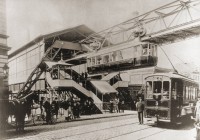 The company's first major project was the Wuppertal Suspension Railway – officially named the 'Eugen Langen suspended monorail system' – whose framework was designed by Anton von Rieppel in the mid-1890s. It took the MAN engineers 8 years to complete it (by 1903), with the whole operations costing around 16 million gold marks. The new system eased transportation from northeast to southwest Wuppertal – Oberbarmen to Wuppertal-Vohwinkel – and passed 12 meters above the Wupper river. The system would be successfully operated throughout the following decade, as it's still used in today's public transportation.
The company's first major project was the Wuppertal Suspension Railway – officially named the 'Eugen Langen suspended monorail system' – whose framework was designed by Anton von Rieppel in the mid-1890s. It took the MAN engineers 8 years to complete it (by 1903), with the whole operations costing around 16 million gold marks. The new system eased transportation from northeast to southwest Wuppertal – Oberbarmen to Wuppertal-Vohwinkel – and passed 12 meters above the Wupper river. The system would be successfully operated throughout the following decade, as it's still used in today's public transportation.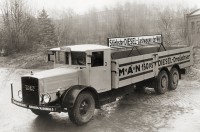 MAN Nürnberg took full advantage of the Diesel technology developed by Rupert Diesel in the late 1890s and manufactured world's very first direct injection Diesel truck. Presented at the Berlin Automobile Exhibition in December 1924, the new truck had taken MAN engineers quite a lot to figure out how to implement a massive stationary-purposed engine into a street vehicle. Due to the massive and robust construction of the cylinders (as it had to resist to very high air pressure) the engine could only produce 1 hp for every 250 kg. The solution came soon after the end of WWI, in 1923, when MAN developed the fuel injection pump. This gave the engineers the opportunity to create a much more simple and light Diesel engine which would fit any truck or heavy-duty vehicle.
MAN Nürnberg took full advantage of the Diesel technology developed by Rupert Diesel in the late 1890s and manufactured world's very first direct injection Diesel truck. Presented at the Berlin Automobile Exhibition in December 1924, the new truck had taken MAN engineers quite a lot to figure out how to implement a massive stationary-purposed engine into a street vehicle. Due to the massive and robust construction of the cylinders (as it had to resist to very high air pressure) the engine could only produce 1 hp for every 250 kg. The solution came soon after the end of WWI, in 1923, when MAN developed the fuel injection pump. This gave the engineers the opportunity to create a much more simple and light Diesel engine which would fit any truck or heavy-duty vehicle.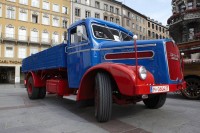
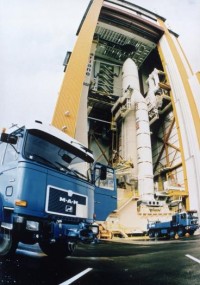 Unlike any other truck manufacturer out there, MAN well-extended its production area in the late '70s. As aeronautic transportation became more and more of a necessity in terms of satellite takeoffs, the German company got involved in producing the necessary launch components, like boosters, fuel & high-pressure tanks and turbopumps. MAN was actually one of the most important manufacturers to support the Ariane program in 1979, with developing the Ariane 1 rocket. Their involvement within the aeronautic industry continued until the present days.
Unlike any other truck manufacturer out there, MAN well-extended its production area in the late '70s. As aeronautic transportation became more and more of a necessity in terms of satellite takeoffs, the German company got involved in producing the necessary launch components, like boosters, fuel & high-pressure tanks and turbopumps. MAN was actually one of the most important manufacturers to support the Ariane program in 1979, with developing the Ariane 1 rocket. Their involvement within the aeronautic industry continued until the present days.